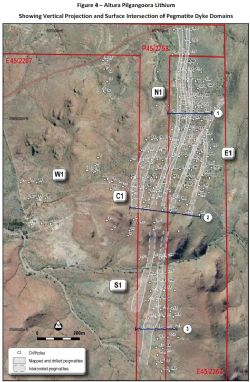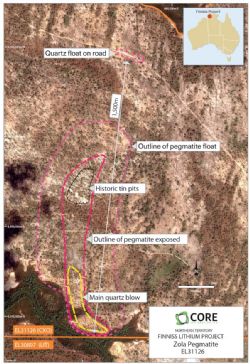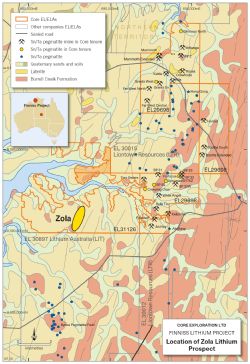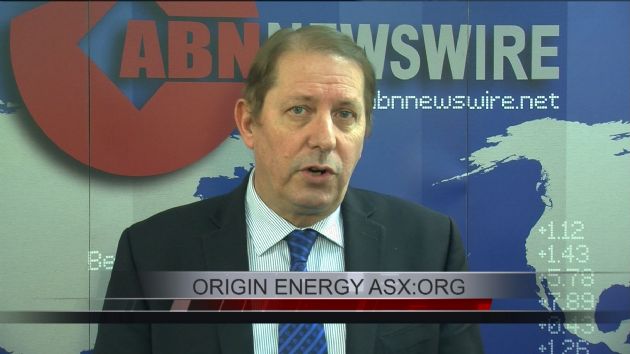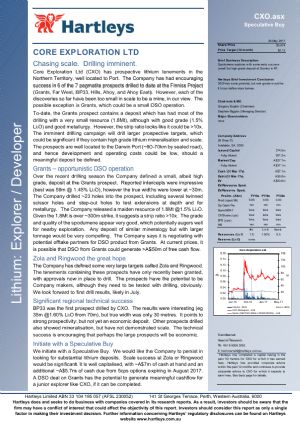
New Large Scale Lithium Pegmatite Target Defined at Finniss
Sydney, June 23, 2016 AEST (ABN Newswire) - Core Exploration Ltd's ( ASX:CXO) is pleased to report it has identified an exceptionally large pegmatite swarm within the Finniss Lithium Project near Darwin in the NT. The Zola Pegmatite is unusually large by world standards and represents an outstanding exploration target for lithium.
ASX:CXO) is pleased to report it has identified an exceptionally large pegmatite swarm within the Finniss Lithium Project near Darwin in the NT. The Zola Pegmatite is unusually large by world standards and represents an outstanding exploration target for lithium.
Highlights:
- Zola Pegmatite over 450m width
- Evidence to suggest Zola Pegmatite is at least 1,500m long
- Previous trench sampling in the 1980's confirmed an unusually large pegmatite with anomalous tin tantalum chemistry
- Scale of Zola Pegmatite comparable to those at Pilgangoora in WA
- Detailed mapping and sampling underway to test lithium grades
The Zola Pegmatite prospect (CXO 100% ELA31126) includes a north-south trending system of pegmatites covering an area conservatively estimated at between 1-2 square kilometres.
The most important aspect of Zola is the scale (Figure 1, see link below). The outcrop of decomposed pegmatite and quartz blows extend for up to 1,500 m NS and could be as long as 2,000m under cover (abundant quartz in road-cutting to the north - Figure 1).
Pegmatite material extends EW for at least 450m at surface, suggesting a substantial swarm of highly fractionated pegmatites.
The scale of the Zola Pegmatite prospect is directly comparable to the scale of pegmatites hosting large resources in the Pilgangoora region in Western Australia (Figure 1).
The Zola Pegmatite is one of the western-most tin prospects within the Bynoe Pegmatite Field; a 15 kilometre wide belt of more than 90 tin and tantalum prospects and mines which stretches in a north-north-east trending direction over a distance of 75 kilometres from Mount Tolmer to Kings Table (near Port Darwin) in the north (Figure 2, see link below).
Work on the Zola indicates that a broad belt of pegmatite injection trends north northeast through the area. The pegmatite consists of coarse grained quartz and muscovite, feldspar and other minerals which are totally decomposed in outcrop, and notable dark minerals, dominantly tourmaline with trace cassiterite and tantalite.
Attention to date has been focussed on the location cassiterite and/or tantalite mineralisation in the pegmatite. Mineralisation at Zola is associated with veins and lenticular bodies of quartz-feldspar-muscovite pegmatites which exhibit sharp intrusive contacts with the host metasediments. There is evidence of a large body of quartzmuscovite (-feldspar) pegmatites (or greisen) at least 1,000 metres long and up to 450 metres wide.
Large blows of nearly massive quartz are scattered through the pegmatite. The large quartz bodies are thought to be cores to the pegmatites. However, much of the mica, feldspar and potential lithium minerals have been converted to kaolinite near surface by weathering processes.
The northern part of the pegmatite is covered with a flat lateritised surface. The top of this surface is characterised by a 1-3 metre thick sheet of ferricrete which obscures much of the basement rocks.
It is not clear from the available literature whether there has in fact been any actual production from Zola (formerly known as the Lost Chinaman Pegmatite) though there is evidence of nearby pitting operations, milling activity and tailings. Extensive costeaning (trenches) also makes it difficult to identify any early mining activity.
In the 1980's, Union Oil and JV partner Kakadu excavated a total of seven costeans (approximately 1000m) across the pegmatite zone. 203 channel samples were collected over intervals of 5m and analysed for Sn, Ta, Y, La, Ce, Nd, Tb and Th. Results indicate highly anomalous levels of tin, tantalum and rare earth metals (LCT Type Pegmatites). 31 rock chips were taken by Haddington in 2006, and results indicating highly anomalous, but "patchy" Sn, Ta and Li levels. The two best Ta results were returned from the very northern extremity of the rock chip sampling.
Core's Finniss Lithium Project has substantial infrastructure advantages being close to grid power, gas and rail infrastructure and within easy trucking distance by sealed road to Darwin Port - Australia's nearest port to Asia (Figure 2).
Next Steps
Although there has been substantial costeaning of the large pegmatite swarm for tin and tantalum the potential of the area for lithium pegmatite mineralisation has clearly not yet been adequately explored and tested.
Core has already commenced mapping and sampling the Zola Pegmatite to improve our understanding of its potential to host lithium mineralisation.
Also there is little doubt that additional mineralised pegmatites, concealed beneath thin laterite cover, occur on extensions of the trend north and south of the known mineralisation within the Zola Pegmatite.
Core is continuing sampling and exploration of pegmatites in the Finniss Lithium Project to define and prioritise drilling of potential targets. Drill applications have already been lodged by Core to enable Core's planned drilling program to commence as soon as possible next Quarter.
To view tables and figures, please visit:
http://abnnewswire.net/lnk/387T1N33
About Core Lithium Ltd
 Core Lithium Ltd (ASX:CXO) is an emerging lithium producer focused on development of its Finniss Project near Darwin in the Northern Territory. Core owns 100% of Finniss, a major developing project that lies close to existing infrastructure such as the Darwin Port, grid power, gas and rail infrastructure.
Core Lithium Ltd (ASX:CXO) is an emerging lithium producer focused on development of its Finniss Project near Darwin in the Northern Territory. Core owns 100% of Finniss, a major developing project that lies close to existing infrastructure such as the Darwin Port, grid power, gas and rail infrastructure.
The Finniss Project covers a 500km2 tenement holding and 25 historic pegmatite mines. The project area is about 80km from Darwin Port. Exploration work has generated a near term development timeline, with feasibility studies to be completed over the course of 2018 ahead of receipt of approvals in early 2019 and planned first production during 2019.
An aggressive exploration program is under way, which has confirmed the high quality prospectivity across much of the Finniss Project area. Core's stated ambition is to upgrade Finniss' resource base to fast-track commercialisation options.
| ||
|



